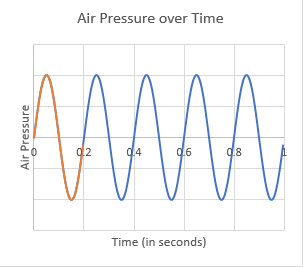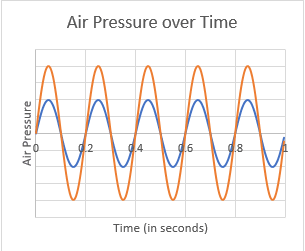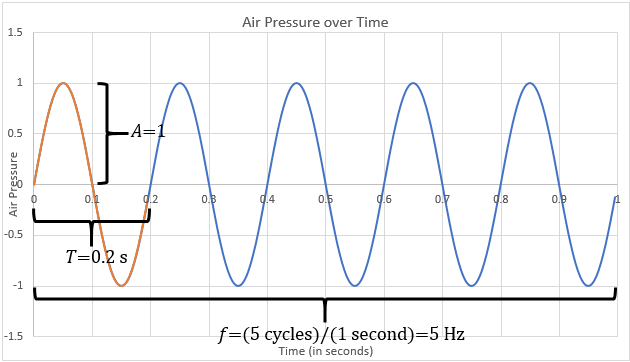Introduction to the Sine Wave
March 29, 2018
Back to: Sine Testing
The sine wave is fundamental to vibration testing. It is the basis of sine testing, which engineers use to identify resonances and validate fixtures. The sine wave also lies at the heart of the Fourier transform, a fundamental tool in analyzing random waveforms.
To get started, we must understand the measurements of sine waves and how they pertain to vibration testing. A sine wave’s frequency, period, and amplitude help to describe vibrational displacement.
Frequency
Figure 1.1 shows a sine wave vibration generated by a tuning fork. It is oscillating with regular frequency and amplitude. A sine wave’s frequency refers to the number of cycles (oscillations) that occur in one second. The orange portion of the wave from 0-0.2 seconds is a single cycle.

Figure 1.1. A sine wave for air pressure over time. The orange portion of the wave from 0-0.2 seconds is a single cycle.
By definition, this sound wave is sinusoidal. Its frequency is the number of pressure cycles that occur in one second.
Period
In Figure 1.1, the air pressure-measuring device recorded five cycles over one second. This means the tuning fork was vibrating at 5Hz, where the unit hertz (Hz) is cycles per second.
The period of a sine wave refers to the time it takes for the sine wave to complete a cycle. It is the inverse of frequency. If the frequency of a wave is 5Hz, then each cycle takes 1/5 of a second to complete. The period of a 5Hz sine wave is 1/5Hz or 0.2 seconds.
Amplitude
A sine wave oscillates with regular frequency and amplitude. We have learned about frequency—the number of cycles the wave completes in one second. Amplitude indicates how far the wave deviates from its position of rest.
The amplitude of the tuning fork’s sound wave would depend on how hard we struck the fork. More force would cause the fork’s arms to move with greater amplitude, and more extreme pressure levels would move through the air.
Sine Wave Vibration
Figure 1.2 illustrates the characteristics of a sine wave on a graph.


